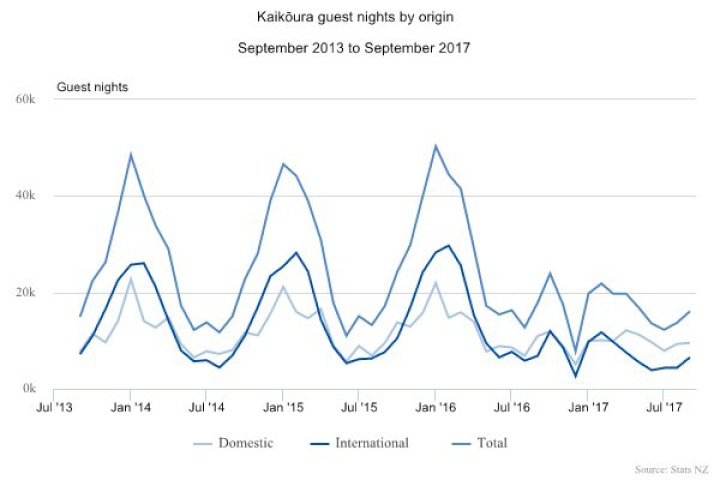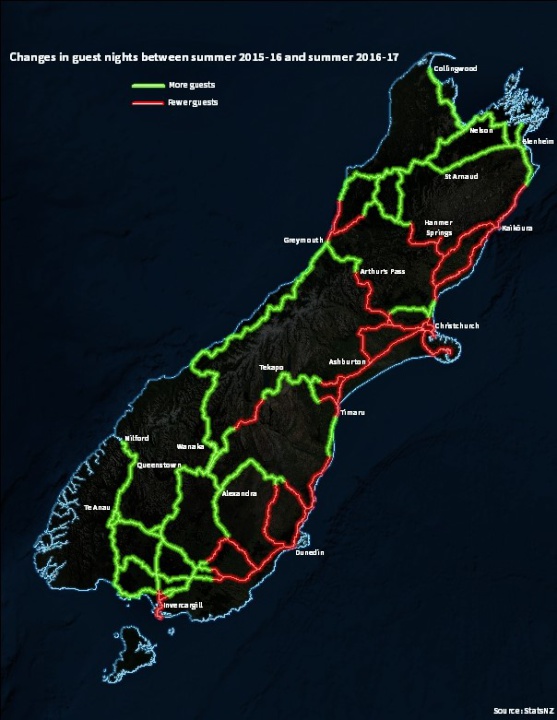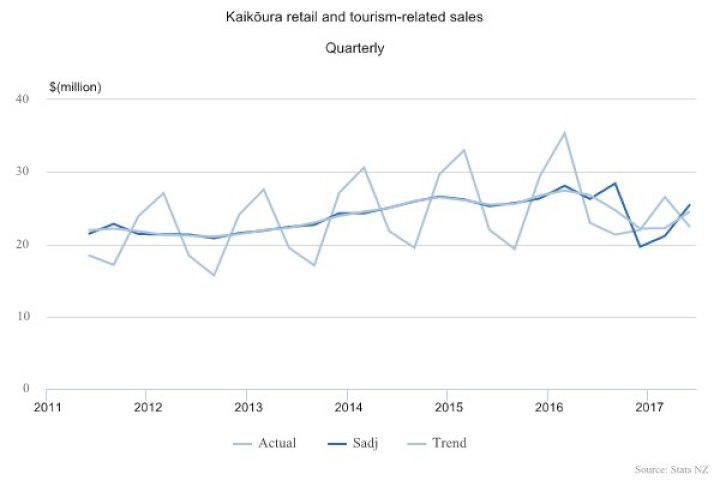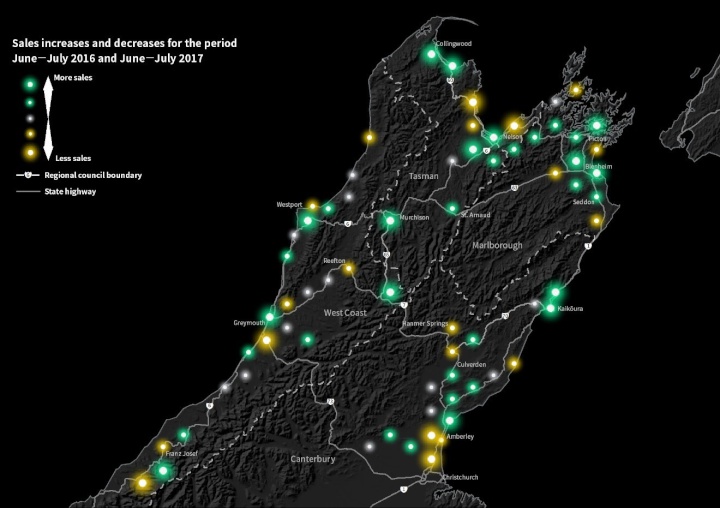Kaikoura recovery by the numbers
Kaikoura recovery by the numbers – Media release
14 November 2017
On 14 November 2016 a magnitude 7.8 earthquake caused major damage to Kaikōura. Roads and rail were closed, so tourists were evacuated by boat and air – leaving Kaikōura’s tourism and hospitality industry cut off from its flow of travellers right before its peak summer period. This story views the initial impact on the district, and subsequent effects, through the lens of statistics.
Short-term commercial accommodation changes
In December 2016 Kaikōura guest nights fell 80 percent from the previous December to the lowest-ever level (see figure 1). January 2017 guest nights more than doubled December’s number, but were still 61 percent below January 2016 and Kaikōura’s usual summer peak. Month-on-month decreases in the Kaikōura district’s total guest nights have generally lessened since then, to surpass a pre-earthquake equivalent month for the first time in August 2017. However, recovery has only reached levels seen in quieter months, and in the year ended September 2017, guest nights were 40 percent lower than the September 2016 year.
Figure
1

While the number of guest nights
appears to have recovered to be close to that of quieter
months (down 10 percent in September 2017 from September
2016), guest arrivals are still significantly lower than
before the earthquakes (down 40 percent over the same
period). Increasing ‘average length of stay’ statistics
show that guests arriving at short-term commercial
accommodation are staying for longer – helping to boost
guest nights. In the most-recent accommodation data
(September 2017) the average length of stay increased to 2.5
nights, up from 1.6 nights in September 2016.
“This longer average stay is likely being pushed up by recovery workers occupying commercial short-term accommodation, which was previously usually used by travellers passing through,” accommodation statistics manager Melissa McKenzie said.
“However, it’s important to note that non-commercial and long-term accommodation, such as temporary villages set up for recovery workers, aren’t included in our guest night measures.”
Underlying changes to the typical guests using Kaikōura commercial accommodation since the earthquakes are also reflected in ‘origin of guest’ statistics. In the year ended September 2017, domestic guest nights accounted for 57 percent of total guest nights in Kaikōura, compared with 45 percent in the September 2016 year.
As access to Kaikōura continues to improve, this could help guest nights recover and cause further changes to the type of guests and how long they stay in Kaikōura.
The changes in guest nights in Kaikōura and the wider South Island since the earthquakes can be seen in an interactive story map shown in figure 2.
Figure 2

Accommodation survey: November
2017 will be published on 12 December.
Impact on tourism also seen in sales
Retail and tourism-related sales in Kaikōura are usually strongly seasonal; tourism bumps summer sales 50 percent above the cooler months. Sales in the December 2016 quarter immediately following the earthquake were down 25 percent ($7.4 million) on the December 2015 quarter.
When road access improved in the March 2017 quarter, sales were 25 percent ($8.8 million) lower than for the March 2016 quarter. The most-recent data available in the June 2017 quarter showed sales were down 2.6 percent ($0.6 million) on the June 2016 quarter (see figure 3).
Figure
3

The September quarter 2017 retail
trade survey results will be published on 23 November, which
will provide more up-to-date regional sales figures. Monthly
retail electronic card data does not break down to a
regional level.
We’ve updated the interactive story map showing Kaikōura sales since the earthquakes, originally published 29 August 2017. It now includes data from April 2017 to July 2017, shown in figure 4.
Figure
4

Usually resident population
relatively unchanged
The estimated resident population in Kaikōura has remained around 3,700 since the earthquakes, despite some people departing and others arriving. The resident population will include some recovery workers, but will exclude workers and visitors who do not usually live in Kaikōura.
In June 2017, an estimated 2,080 people lived in Kaikōura township, and 1,640 in the Kaikōura rural area. This compares with 2,010 and 1,620, respectively, in June 2013.
Ends
For media enquiries contact: Melissa
McKenzie, Christchurch 03 964 8439, info@stats.govt.nz
Published 14
November 2017
See also:
Accommodation shake-up – maps showing the effects of the earthquake on guest nights across the South Island over time.
Business shake-up – maps showing the effects of the earthquake on retail and tourism-related sales across the upper South Island over time.
Accommodation survey: September 2017
Retail Trade Survey – information releases
Kaikōura township quarterly time series – data notes.
Upper South Island maps – data notes.
Electronic Card Transactions – information releases
Population estimates and projections
Infoshare.
Tables (Excel)
(See attached file:
as-kaikoura-sep17-tables.xlsx)
askaikourasep17tables.xlsx


 Gordon Campbell: On The New Pope, And The Israeli Attack On Peter Davis
Gordon Campbell: On The New Pope, And The Israeli Attack On Peter Davis New Zealand Labour Party: Labour Asks Why Govt Is Silent On Gaza
New Zealand Labour Party: Labour Asks Why Govt Is Silent On Gaza Transport Accident Investigation Commission: Near-Collision Highlights Safety Lessons For All Busy, Unattended Aerodromes
Transport Accident Investigation Commission: Near-Collision Highlights Safety Lessons For All Busy, Unattended Aerodromes Green Party: Wildlife Law Change A Deep Betrayal Of Public Trust
Green Party: Wildlife Law Change A Deep Betrayal Of Public Trust NZCTU: Unions Launch Petition To Protect Pay Equity
NZCTU: Unions Launch Petition To Protect Pay Equity Greenpeace: Greenpeace Slams PM’s Science Pick - 'Polluters Are Running The Show'
Greenpeace: Greenpeace Slams PM’s Science Pick - 'Polluters Are Running The Show' NZ Government: PM’s Science Prizes Celebrate Excellence
NZ Government: PM’s Science Prizes Celebrate Excellence


